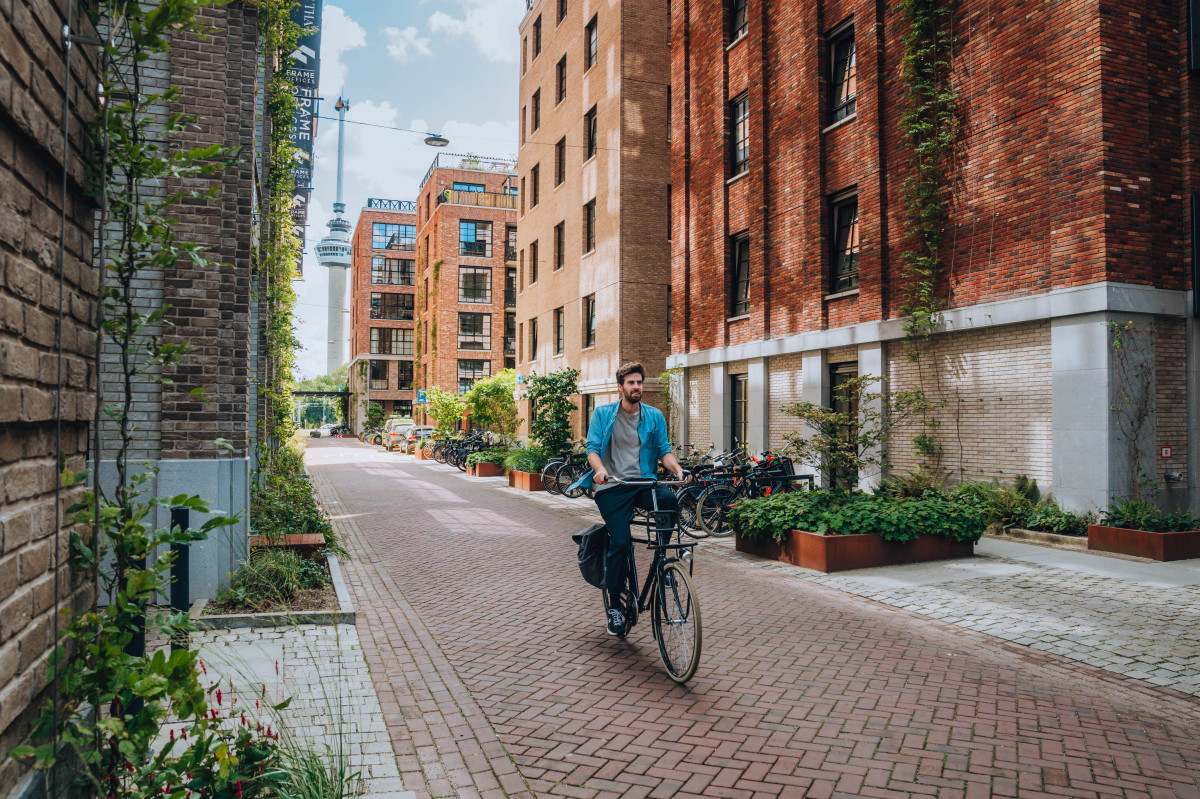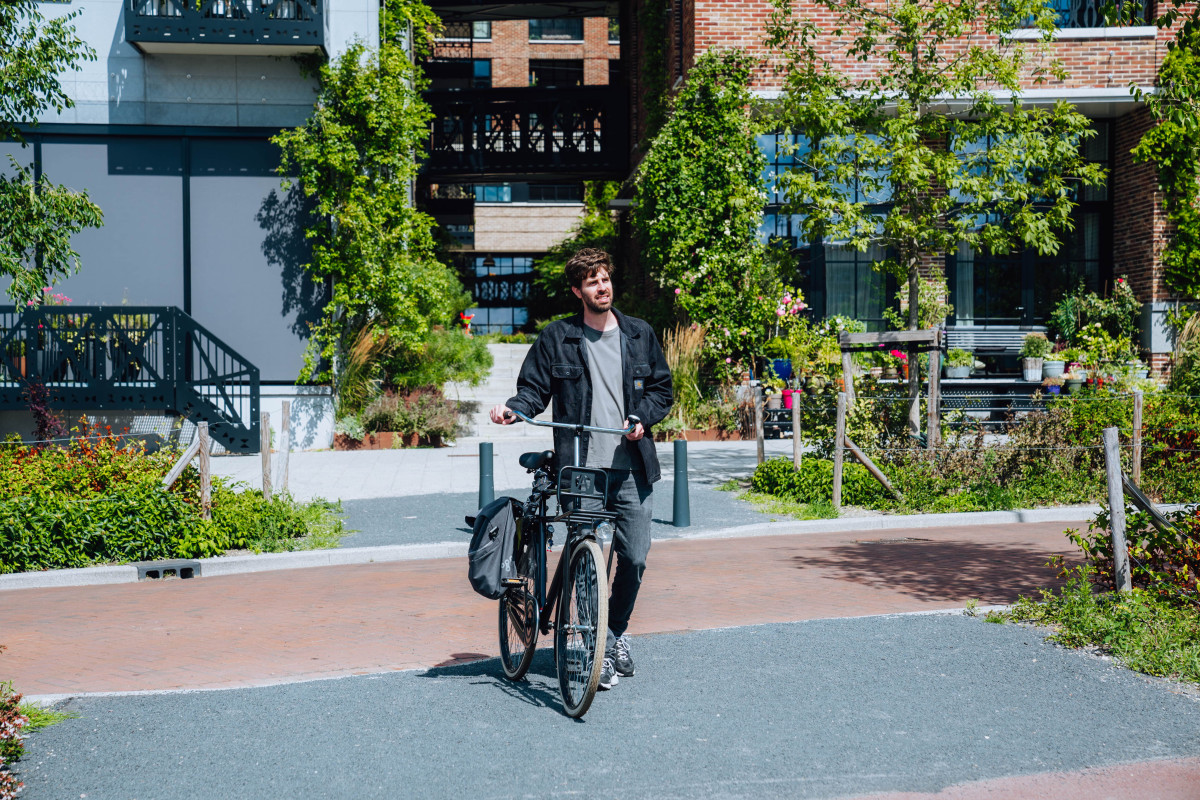Let’s talk about the elephant in town. Lior Steinbergurban planner and co-founder of Humankind, a multidisciplinary urban change company, has an interesting metaphor that describes people’s relationship with the spaces around them. An elephant locked in a small cage is sick and depressed. Instead, in its natural habitat, where it has space and company, it thrives. It is the same for humans: we are strongly influenced by the environment in which we live.
“The essential difference between humans and elephants is that we have the unique ability to create our own environments. While the elephant has no control over the zoo that humans build for him, we have the power to build our own cities by shaping the environment around to support our well-being”, says Lior.
In his work, Lior Steinberg looks beyond functionality and wants to create cities for people. In 2022, Lior published “The Car That Wanted To Be a Bike”, a children’s book about the joy of cycling and the future of cities.
Lior will talk about all of this at Unfinished, which runs during the period September 27-29. This year’s theme of the festival is Praxis: about connecting theory with practice, about how we can transform ourselves from receivers to creators. (The only way to participate in UNFINISHED is by completing an application and a selection process carried out by the festival organizers).
In anticipation of Unfinished, we talk with Lior about how we can create spaces for people and not machines, about friendly cities and happy elephants.
Important stages in your training
Before studying Urbanism, I was a programmer. I love technology, but I’ve always been fascinated by how cities are built. As a child, I would walk with my father, wondering who designed the streets and spaces around us. I had no idea then that urban planners existed.
When I was 20, I gave Jane Jacobs the works. Even though she was writing about cities in the 1960s, her critique of car-oriented urbanism is still painfully relevant. It stirred something in me. That’s when I knew I wanted to make a change and become an urban planner. I eventually followed this path by enrolling in a master’s program at Stockholm University.
The chapters of your life
There would be three.
The first chapter is Childhood in the city. I grew up in Tel Aviv, and the city shaped the way I grew up. A vibrant place full of experiences, people and lessons that have deeply influenced me. Over the years, I have also come to understand how the endless war has affected me and the people around me.
The second chapter is Becoming a city maker. That’s when I realized that I can actively shape cities. I moved to Europe, settled in Rotterdam and co-founded Humankind with Jorn Wemmenhove. This was when my passion for urban planning really took root.
The third chapter began this summer with the birth of my first son, Nuri. It is a significant change in my life and I am excited to raise Nuri in Rotterdam. I look forward to seeing how we can work together to make it a better place for children, families and all residents.
How has the perspective on your role changed?
If your perspective doesn’t change over time, you’re either a born genius or, more likely, an absolute ignoramus. So naturally my perspective evolved as I learned and grew in my profession. I made – and still make – a lot of mistakes along the way.
When I started, I thought everyone wanted to live the kind of lifestyle that big cities offer. But I quickly realized that smaller towns have their own unique qualities. I learned this when I lived in Groningen, a Dutch city of about 200,000 people. Finally, I experienced the richness of smaller cities as places where you can enjoy convenience, quiet, and a sense of familiarity that larger cities often lack.
Now, with this experience, I try to bridge the gap between big cities and small towns, looking for ways to bring small-town qualities—such as accessibility and community—to larger urban areas or specific neighborhoods.
The story of Humankind
Humankind it is a response to a growing dissatisfaction with the way our cities have been shaped. Actually, I started as Street Makersa collaboration between myself and Jorn. Our initial idea was to use tactical urbanism – temporary interventions on streets – to make them more people-friendly. We wanted to create spaces where people could pedal, enjoy more greenery and generally have a better experience.
As we evolved, we began to take on more projects, diving deeper into areas such as cycling infrastructure and permanent urban solutions. It became clear that we needed a name that reflected the larger vision we had, and so Humankind was born. The name represents not only our vision for cities – places based on the idea of humanity – but also our mission: to create urban environments that truly support and nurture people.
How people’s relationship with the space they live in has changed
I often compare people’s relationship to the space they live in with elephants in a zoo. In a poor zoo, where an elephant is locked in a small cage, deprived of adequate food and isolated from the other elephants, you can see that it is suffering. He is sick, depressed and has a much shorter life span. Instead, in their natural habitat, with plenty of space, companionship and abundant food, elephants thrive.
The same is true for humans. We are strongly influenced by the environment in which we live. A person who lives in a city with bike lanes is much more likely to ride a bike. Although the decision to cycle or drive is personal, it is significantly influenced by the surrounding infrastructure. Similarly, people living in green areas are more likely to engage in outdoor activities simply because those spaces are available.
People who live in green, walkable and low-traffic areas tend to live longer. They are healthier, have happier lives, with greater satisfaction. The essential difference between humans and elephants is that we have the unique ability to create our own environments. While the elephant has no control over the zoo that humans build for him, we have the power to build our own cities, shaping the environment around us to support our well-being.
Human needs in 2024
Whoever has the answer to this question should probably get a Nobel Prize. When it comes to cities, I think our needs haven’t changed in the last century. People need to be able to get to safe places, support their families, and meet, learn, and create experiences with other people. As more people end up in cities, providing such places becomes more of a challenge, but that doesn’t mean we should stop trying.
Public spaces in the future
It’s quite simple: places where people of all ages and abilities can come together safely. It can be as small as a street corner with a bench and a tree or as large as Central Park. And more importantly, great public spaces are also about how people can get to them: on foot, by bike or by public transport. This means that we need to improve not only our squares and parks, but also our streets.
A present-day city that comes closest to the ideal city
It’s hard to pinpoint a single city that embodies the ideal in 2024. Instead, I think we have so much to learn from diverse cities around the world, each offering unique approaches and solutions. Only in Europe do cities continuously exchange ideas and practices to improve urban life. Dutch cities like Amsterdam, Utrecht and Groningen are a great example of making cycling easier than driving a car. Barcelona’s squares are a worldwide example of inclusive public spaces. Warsaw shows how urban parks can be an oasis of greenery in a crowded city.
The key is to learn from each other and adopt best practices that suit our specifics.
Participation in Unfinished
I like the concept of multidisciplinary events. The solutions for our society are not only in the hands of specialists. Our cities need more than architects and planners. They need artists, thinkers, teachers, accountants, farmers and more. The idea of a festival that tackles social issues through a multidisciplinary approach is incredibly interesting to me.
#Practice. Personal definition
Praxis is a type of public action, political and based on the shared experiences of individuals in a community, according to Hannah Arendt. In this way, urban life, with its opportunities for personal expression, social interaction, and political engagement, embodies this idea. As an urban planner, the opportunity to explore concepts in the urban environment is very interesting, especially since it’s not a given: some cities do it better than others, and it’s interesting to explore that during the festival.
The most important social challenges in 2024
We still struggle to live with so many people in a very small space. Bucharest, for example, has around 9,000 people per square kilometer. It leaves very little space per person, which we all have to share. But we use space very inefficiently. Take our transport systems for example: in most of the world they are based around the automobile. It’s an incredible waste of space: a car can carry five people, but most of the time it’s either parked or moving one person. We have built our cities around the car, and now it is very difficult to reverse the process because people – and politicians – are addicted to the automobile lifestyle. This is probably the biggest challenge in creating greener and more livable cities.
Fears. And optimism
Look at the war in Gaza. Millions of people are suffering and tens of thousands have been killed. Since October, every day I hear terrible news: children lose their families, parents bury their babies, people lose everything they have. It’s scary because it leads to another generation of kids who hate the other side. But there is hope. Despite all these horrors, there are people on both sides who continue to choose reconciliation over revenge.
Take, for example, Palestinian peacemaker Aziz Abu Sarah and Israeli peacemaker Maoz Inon, who discussed this topic at TED. These are the leaders of the future.
A name for the time we live in
The era where we broke everything – and then figured out together how to fix it. At least, I hope the second part is true.
Source: www.iqads.ro





